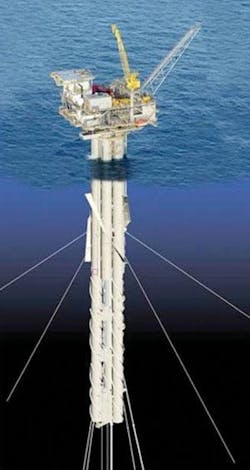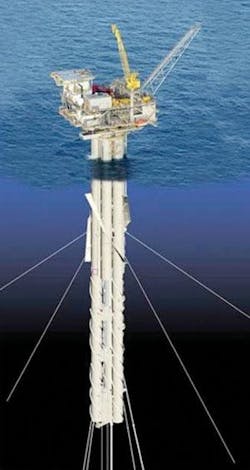Polyester mooring for Red Hawk among first in GoM
Test inserts monitor mooring performance
Todd Veselis
Tom Fulton
InterMoor Inc.
Jenifer Tule
Kerr-McGee Oil & Gas Corp.
Mark Huntley
Whitehill Manufacturing Corp.
Kerr-McGee’s Red Hawk spar production facility, located in Garden Banks 877 in 5,300 ft of water, is one of the first permanent field developments to use a polyester mooring system in the Gulf of Mexico.
The mooring incorporates two 45-ft polyester inserts per leg. They are to be removed periodically to test the in-service characteristics and long-term performance of the polyester moorings. The first insert removal was completed recently.
The concept of polyester test inserts was first developed in the mid-1990s by Petrobras in Brazil to gather information and monitor the performance of its polyester mooring systems for mobile offshore drilling units (MODU) and production facilities. At the time, experience with polyester moorings was limited, and the test inserts offered a method of gathering data and evaluating the long-term behavior of this emerging technology. Since that time, polyester ropes have been extensively tested, and all of the testing to date has shown that polyester rope has a longer life than the other mooring components currently in use.
The first two permanent polyester moorings in the Gulf of Mexico were both installed in 2003 and both included test inserts. While a considerable amount of testing was performed on polyester both in the field and in the lab prior to the installation of these systems, a comprehensive historical database of polyester properties and performance characteristics was not available. Regulatory agencies viewed the test inserts as a means to obtain this test data and to monitor the integrity of the polyester moorings throughout the life of the field. Therefore, test inserts are included as required for regulatory approval.
Kerr-McGee operates Red Hawk with a 50% working interest, and Devon Energy holds the remaining 50% working interest. The spar’s mooring consists of six chain-polyester-chain taut leg moorings, each terminated at the seafloor with suction embedded anchors (SEAs).
Each mooring contains approximately 500 ft of 4 1⁄2-in. studless anchor chain, 7,100 ft of 8 1⁄2” polyester rope, and 500 ft of 4 1⁄2” studless chain at the fairlead. The polyester rope is designed to be torque free and has a minimum break load (MBL) of 2,750 kips. The polyester rope used on the Red Hawk spar was designed and fabricated by Whitehill Manufacturing Corp., with each leg containing a total of five sections.
Each mooring leg contains three main sections and two 45-ft test insert sections. The test inserts are located in the upper part of the mooring just below the fairlead chain. The polyester sections are connected to each other and to the adjacent chain sections using H-link connectors. Each mooring leg also is equipped with a subsea connector, which allows the mooring to be disconnected from the SEA.
The polyester mooring rope consists of 10 subropes, with each subrope constructed from three strands in a wire-lay construction. The subropes are individually spliced and bundled together in a parallel fashion to form the rope. Each strand of the subrope includes a “strand jacket,” which provides protection against abrasion and soil ingress. The rope also is equipped with an outer braided jacket encompassing all of the subropes and provides additional protection.
The rope construction described above offers several advantages in regards to testing the rope. Since the polyester mooring rope is constructed out of 10 individual subropes, one test insert allows for multiple tests to be performed at the subrope level. The results can then be scaled up to project the full-scale rope performance. This allows much more data to be collected as opposed to one full-scale data point. Testing on the subrope level also provides increased flexibility on the number of facilities capable of performing the testing because the required capacity of the test bed is reduced.
The mobilization for the removal of the Red Hawk test insert began on May 11, 2005. The offshore operations were performed using two anchor-handling towing supply (AHTS) vessels, theLaney Chouest and the Seacor Relentless.
TheLaney Chouest was used as the primary vessel to recover and replace the test insert, while the Seacor Relentless was used as the assist vessel to maintain clearance between the polyester and seabed during the recovery operation.
After both vessels were securely connected to the mooring with the assistance of the ROVs onboard theLaney Chouest, the fairlead chain was deployed from the spar to provide adequate slack in the mooring line and enable recovery of the insert on the deck of the Laney Chouest.
The polyester test insert was removed and replaced with a spare. The operation was then reversed, the mooring line lowered into the water, and the two vessels disconnected from the mooring line. A complete ROV inspection of each mooring line was performed prior to departure from the field. The total duration of the test insert recovery, replacement and ROV inspection was approximately six days including mobilization and demobilization.
The removal of inserts and the subsequent testing is performed as part of Kerr-McGee’s Inspection Maintenance Repair and Replacement (IMRR) plan. The IMRR outlines the inspection and test insert removal schedule for the polyester mooring as well as a description of the tests that are to be performed. In the case of the Red Hawk mooring system, the schedule is such that the first insert was to be removed for testing within 12 months of installation.
Subsequent insert removals are scheduled for every 30 months after the initial insert recovery. In addition to the scheduled insert recoveries, an insert must be removed for testing following a storm that equals or exceeds the design storm criteria. Once the insert has been removed from the mooring the IMRR calls for a visual inspection of the rope and then for the outer jacket to be removed prior to testing. The rope is then disassembled to the subrope level for testing.
A variety of tests are then conducted on the various subropes including residual strength, modulus, yarn analysis, residual fatigue and creep tests. The test insert was removed in May 2005 as part of the 12-month inspection as dictated by the IMRR and was the first test insert to be removed from a permanent polyester mooring in the Gulf of Mexico. The testing of the subropes from the insert is ongoing. The tests performed to date have met the pre-determined test criteria and have demonstrated that the rope has “like new” properties.
The use of polyester test inserts has been the subject of much debate over the last few years as the prospect of permanent polyester mooring systems in the Gulf of Mexico has turned into reality. The increased performance offered by a polyester mooring system, coupled with increasing water depths and steel costs, continues to make polyester moorings more attractive.
Current regulatory requirements recommend that test inserts be included in all Gulf of Mexico moorings and that these inserts be removed regularly for testing. This practice offers advantages to the operators, regulatory agencies and the industry as a whole. The test data provides information on the long-term behavior of polyester and in-service rope properties.
The current test program captures polyester performance characteristics during normal operating conditions and extreme operating conditions such as hurricanes and loop current events. The program is designed to monitor the effects, if any, of both high-cyclic and high-static loading on polyester moorings. Once several inserts have been removed and tested, the data will prove useful to mooring system designers and polyester manufacturers and provides a data set for regulatory agencies.
The test program can be organized, as in the case of Red Hawk, to perform accelerated tests on the samples to help identify any unforeseen changes in strength or behavior of the rope before they occur or become critical. While this data is useful, currently there is no standardized test philosophy in place to capture data on the various ropes constructed and used in the Gulf of Mexico. A standardized means of compiling data would allow the industry to effectively use the test data that has been gathered.
Although there are a number of advantages to the test insert program, there also are some disadvantages. The test insert program results in increased costs, the majority of which comes from increased operating expenses. The removal of a test insert currently requires the mobilization of at least one AHTS or construction vessel and an ROV spread.
Expenses accumulate each time the test is repeated during the life of the field. Another disadvantage of test inserts is they introduce a greater number of splices and connecting hardware to the mooring system. Because of the elasticity of polyester and stroke limitations on test beds, inserts are typically limited to approximately 45 ft in length. Some believe that these short sections make it more difficult to achieve proper load sharing between the subropes.
The combination of the length, the increased number of splices and additional connecting hardware could potentially weaken the system. In addition, there is the potential for damage to mooring during insert removal. The most likely occasion for any mooring component to sustain damage is during installation and handling. Each additional operation increases the potential for damage to the polyester itself as well as the connecting hardware.
The industry continues to debate whether additional test data obtained from polyester inserts justifies the cost and additional risk of damage. Other methods to monitor the integrity of polyester mooring systems are being investigated. These include inserting fiber optics in the rope and using visual rope life indicators. Until an alternative is found, test inserts are a viable method to monitor the long-term operational characteristics of polyester moorings.•

